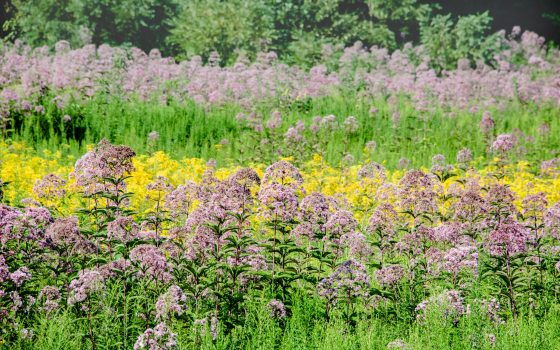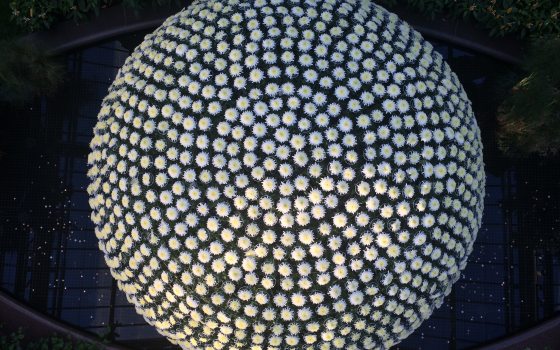Editor’s Note: This blog article was slightly edited on 8/28/19 to update information on aster family blooms currently on view in the Meadow Garden.
If you look out across the Meadow Garden in late summer and early fall, you’ll see large swaths of gold dotted with purple. These spectacular blooms come from members of the Asteraceae or aster family, one of the largest families of flowering plants on the planet. While many cultivated plants in the Asteraceae are found throughout Longwood’s display gardens—from daisy-like gerbera and dahlias, summer favorites marigolds and zinnias, and fall’s spectacular asters and chrysanthemums—it’s in the Meadow Garden where you can truly appreciate the breadth of this plant family in a natural setting.
With more than 1,600 genera and 23,000 species recognized by scientists, the Asteraceae classification encompasses herbaceous and woody plants that grow in all kinds of environments from wet to dry ... and our Meadow Garden, with its dry and wet areas, puts on a spectacular aster show this time of year. In the Meadow Garden you’ll see everything from towering sunflowers (Helianthus) to colorful goldenrods (Solidago), black-eyed and brown-eyed Susan (Rudbeckia), ironweed (Vernonia), and New England asters (Symphyotrichum novae-angliae) to the humble fleabane (Erigeron) and downright homely pilewort (Erechtites hieraciifolia).
You’ll also find a few of the common “weeds” that are the bane of gardeners: dandelions (Taraxacum officinale), thistles (Cirsium), and the dreaded ragweed (Ambrosia, amusingly named).

Native field thistle (Cirsium discolor) adds late-season color to the Meadow Garden. Photo by Carol DeGuiseppi.
Members of the Asteraceae have composite flower heads. These inflorescences (or a group of flowers) consist of many small flowers (florets) that together can resemble a single, larger flower. Small disk florets, which are the fertile flowers, usually form the center of the flower head. In many members of the aster family, these fertile flowers are surrounded by larger, sterile ray florets, which give the inflorescence the daisy-like appearance we usually associate with these plants.
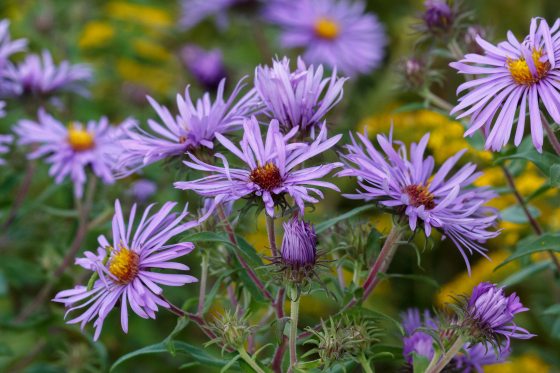
A close look at the inflorescence of a New England aster (Symphyotrichum novae-angliae). Photo by Tom Potterfield.
Asteraceae flowers may be insect or wind pollinated, and they produce a dry fruit called an achene that contains a single seed. Achenes—what we typically call simply the seeds—can range in size from the relatively large sunflower seeds enjoyed by birds to the tiny seeds on the bristles of dandelions that we’ve all blown from their flower heads at one time or another. Many aster-family plants and seeds are important food sources for birds and other wildlife, and some are enjoyed by humans as well.
Among the dozens of species of Asteraceae that can be found in Longwood’s Meadow Garden, here are a few noteworthy examples that you can enjoy in the upcoming weeks:
Sunflowers peak in the late summer and early fall. Notice that native species of this wildflower have much smaller flower heads than the cultivated varieties we are used to seeing in our gardens. The native sunflowers also characteristically have multiple flower heads on a main stalk rather than one large head as we might expect.
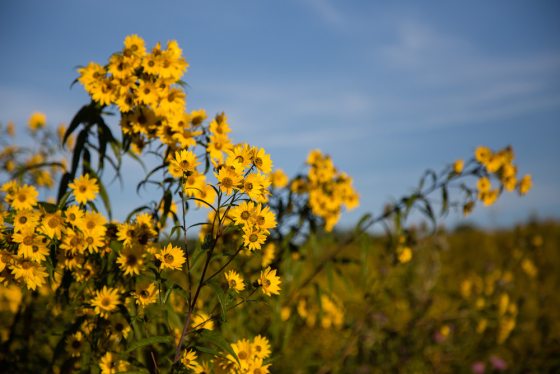
Sunflowers (Helianthus) can stretch upward of 8 feet. Photo by Carol DeGuiseppi.
Longwood’s sunflowers can grow to be quite tall, with many over 8 feet, and line the paths of the Meadow at this time of year.
Asters (Eurybia and Symphyotrichum) are the late-bloomers of the Meadow Garden. Right now you can enjoy beautiful New England asters (S. novae-angliae), which range in color from deep purple to bright pink, as well as lovely white woodland asters (E. divaricata).
As the season continues to progress, many more species will come into bloom, with flower colors ranging from deep blues and purples to delicate whites. Medium to short in height, the asters make a wonderful contrast tucked into the spreads of yellow-flowered late-blooming goldenrods.
Goldenrod (Solidago) and the similar-appearing Goldentop (Euthamia) are prevalent now and into the fall. The different species of this plant make an impressive presentation of golden plumes, mounds, and elm-like flower structures visible across the Meadow Garden.
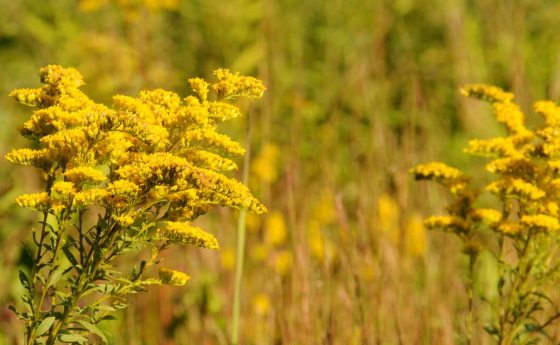
Late goldenrod (Solidago altissima) casts a glow on the Meadow Garden.
Note that while many people attribute allergy flare-ups to goldenrods, these plants are primarily insect pollinated. It is their wind-pollinated brethren blooming at the same time that are usually the source of the problem.
Because the Meadow Garden is part of Longwood’s natural lands and not heavily cultivated, it is subject to invasions of noxious plants just like any other natural area. So it’s helpful to identify the uninvited ragweeds, whose wind-blown pollen will be tickling our noses very soon. You may be surprised to learn that these plants are also members of the aster family. Two species are found here: common ragweed (Ambrosia artemisiifolia) and giant ragweed (A. trifida). But they are only a tiny drop in the wide sea of more inviting and enjoyable aster species gracing the Meadow Garden, ready to be explored.
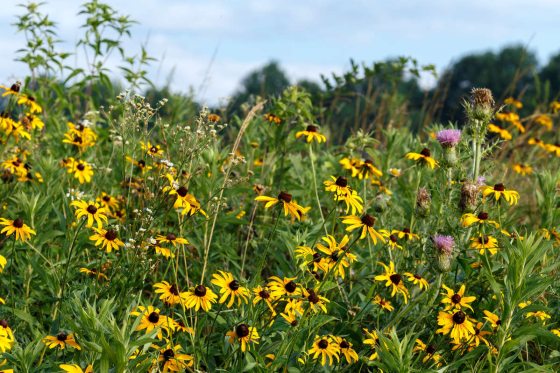
Rudbeckia hirta (Black-eyed Susan) grace our Meadow Garden. Photo by Tom Potterfield.
